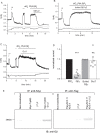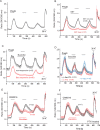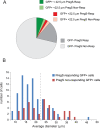Inhibition of Transient Receptor Potential Melastatin 3 ion channels by G-protein βγ subunits
- PMID: 28829742
- PMCID: PMC5593506
- DOI: 10.7554/eLife.26147
Inhibition of Transient Receptor Potential Melastatin 3 ion channels by G-protein βγ subunits
Abstract
Transient receptor potential melastatin 3 (TRPM3) channels are activated by heat, and chemical ligands such as pregnenolone sulphate (PregS) and CIM0216. Here, we show that activation of receptors coupled to heterotrimeric Gi/o proteins inhibits TRPM3 channels. This inhibition was alleviated by co-expression of proteins that bind the βγ subunits of heterotrimeric G-proteins (Gβγ). Co-expression of Gβγ, but not constitutively active Gαi or Gαo, inhibited TRPM3 currents. TRPM3 co-immunoprecipitated with Gβ, and purified Gβγ proteins applied to excised inside-out patches inhibited TRPM3 currents, indicating a direct effect. Baclofen and somatostatin, agonists of Gi-coupled receptors, inhibited Ca2+ signals induced by PregS and CIM0216 in mouse dorsal root ganglion (DRG) neurons. The GABAB receptor agonist baclofen also inhibited inward currents induced by CIM0216 in DRG neurons, and nocifensive responses elicited by this TRPM3 agonist in mice. Our data uncover a novel signaling mechanism regulating TRPM3 channels.
Keywords: DRG neuron; G-protein; TRPA1; TRPM3; TRPM8; mouse; neuroscience; sensory ion channel.
Conflict of interest statement
The authors declare that no competing interests exist.
Figures















Comment in
-
A new target for G protein signaling.Elife. 2017 Sep 11;6:e31106. doi: 10.7554/eLife.31106. Elife. 2017. PMID: 28891794 Free PMC article.
References
Publication types
MeSH terms
Substances
Grants and funding
LinkOut - more resources
Full Text Sources
Other Literature Sources
Molecular Biology Databases
Miscellaneous

